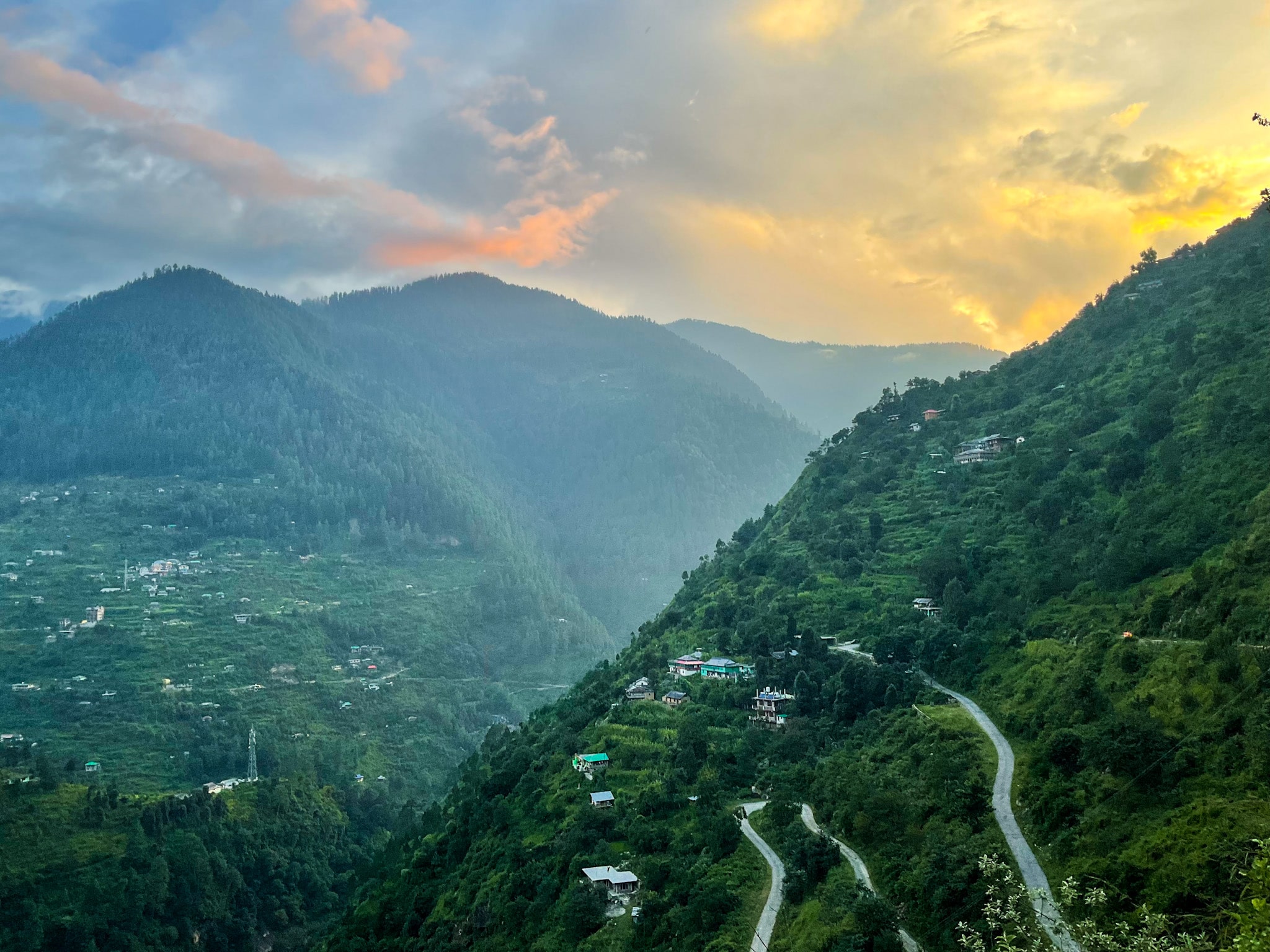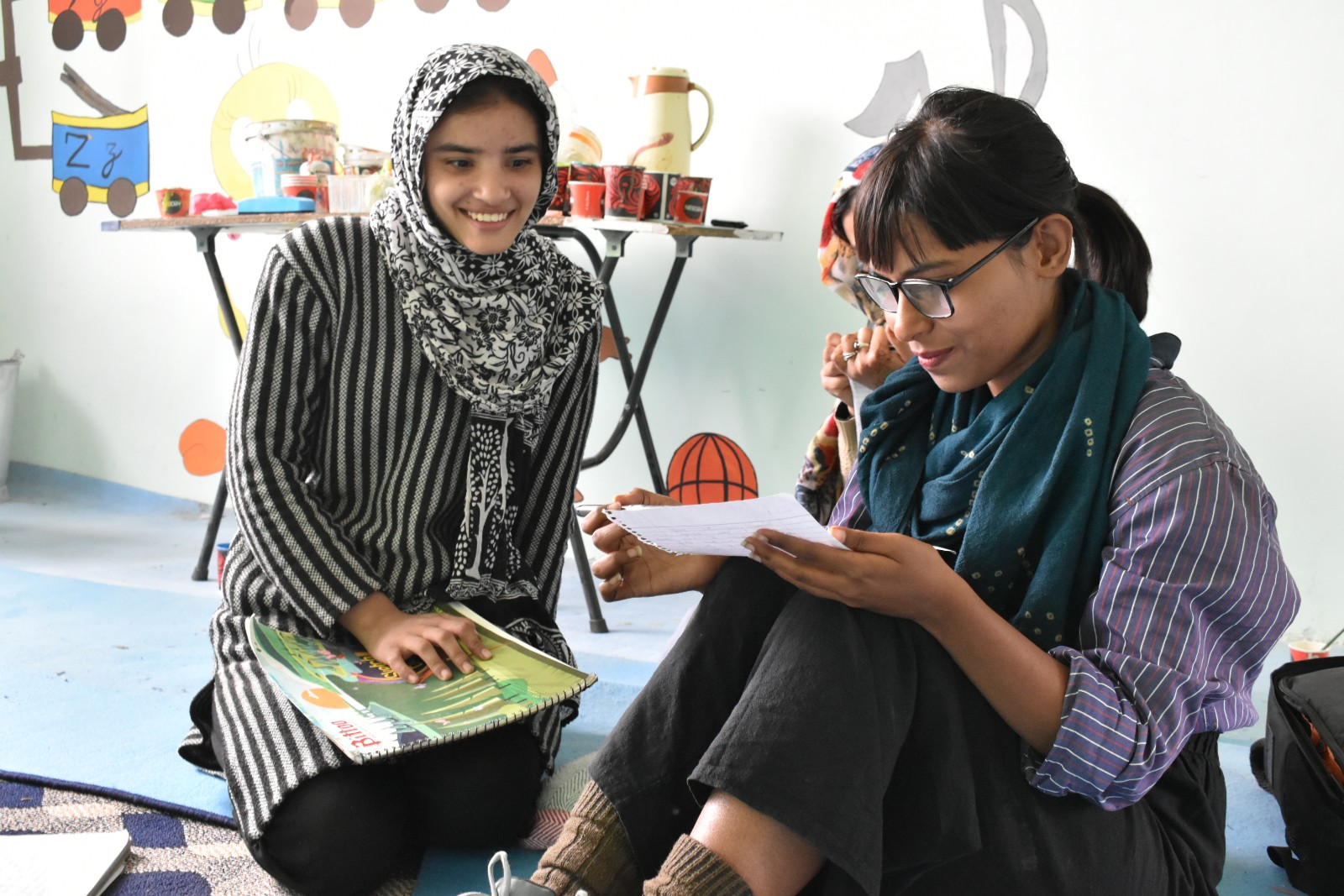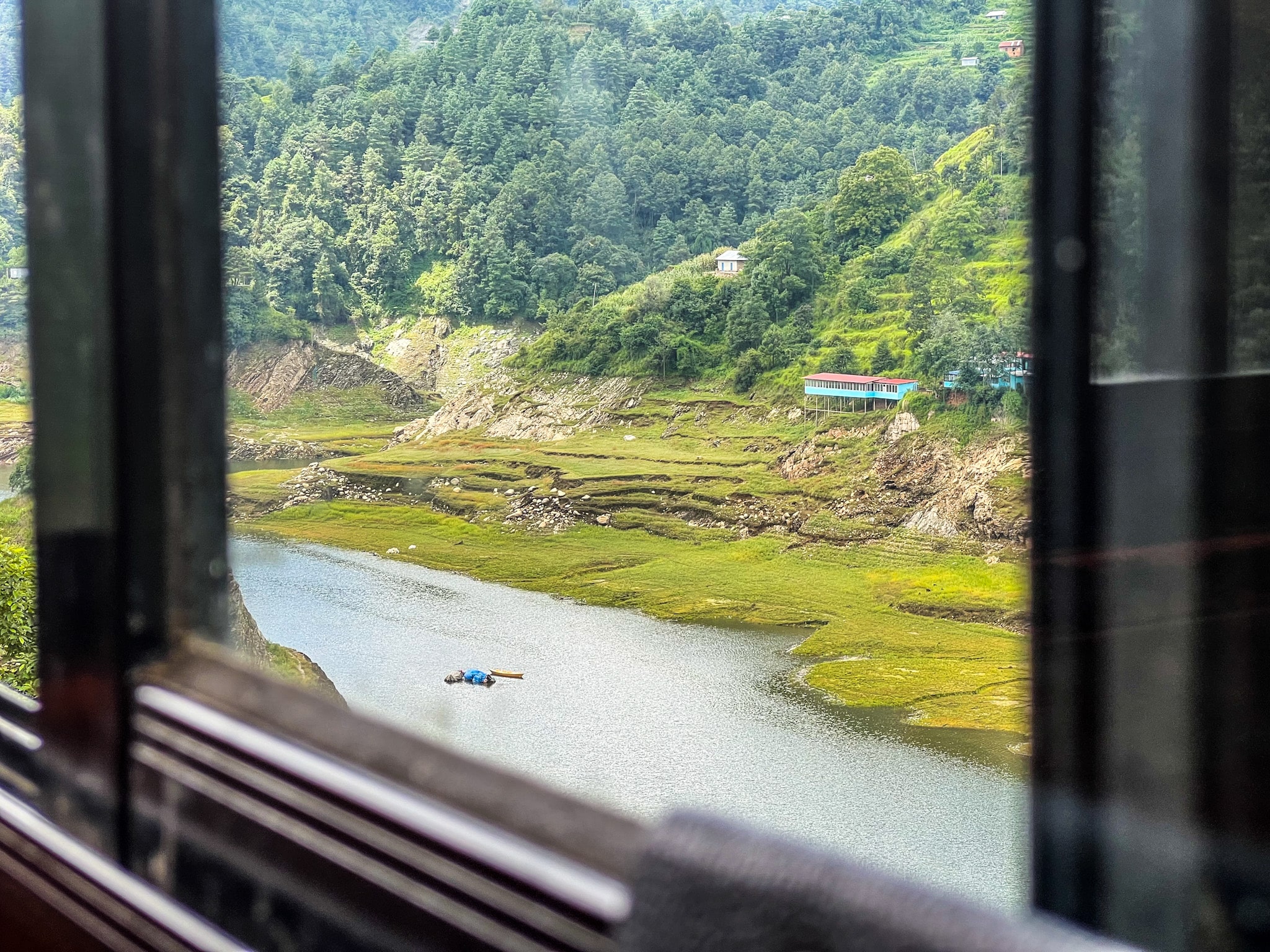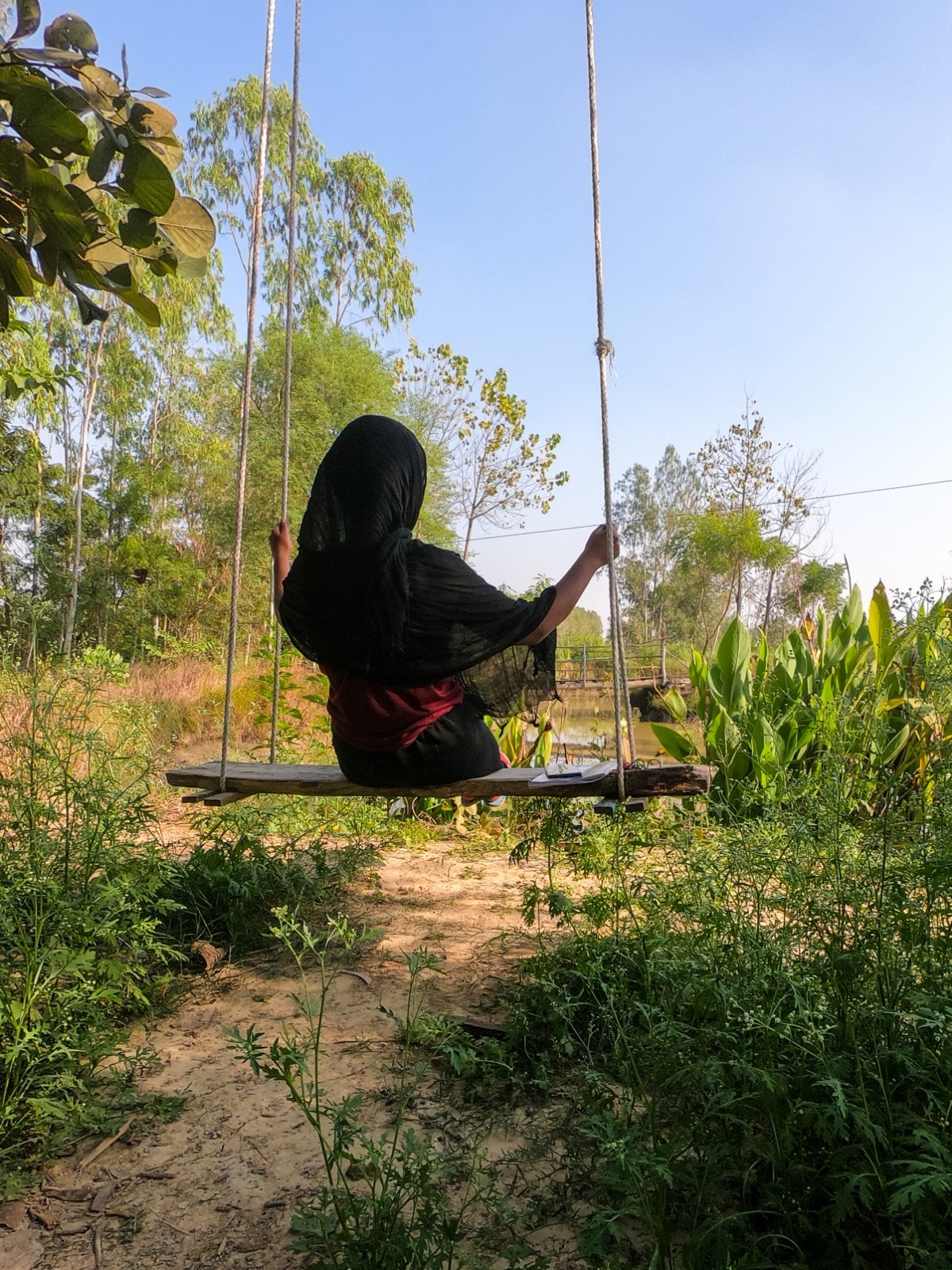One month in Village Kulthi in Tirthan Valley, volunteering, admiring the sunsets of Tirthan, and learning to prepare Siddu, the local Himachali dish!
‘Do you know how to make Seera?’ Virender Bhaiyaa asked while climbing the tree that branched out to the first floor of this Himachali homestay in Tirthan Valley.
Even though we have a wooden staircase, Bhaiyaa surely prefers to climb the 200-year-old oak tree to pass me food or to simply use it as a regular pathway.

Before Tirthan Valley, last year in Bir, the second-highest paragliding site in the world, I tracked down that one cafe that serves local Himachali food. Pity, only one cafe among hundreds! The chef is Himachali, and that local cafe is called Cafe Buransh. Siddu, Rice Babru, Seera…. Apart from authentic Tibetan dishes, Bir is where I leveraged a better tongue for Himachali local food.
On Dussehra, sitting in rows at the school ground of a monastery for Kangri Dham, in the traditional serving of various dishes, particularly nine kinds of veg-items, and leaving the ground with a stuffy full-belly, I got to know more about Himachali culture that to the tourists has become more about drugs and beautiful mountain-landscapes!
Slow Life in Tirthan Valley
I don’t want to stuff the individual goodness into the exterior of ‘Himachali Hospitality’. Virender Bhaiyaa lives a slow life, taking one chore at a time. Immensely busy with non-busy strides. Now that the grass-cutting season is upon them, the house-lights flick up in the borderline darkness of the chilly mornings at 5 am. The mother, the grandfather, and the in-laws wrap up their early mornings with hours of cutting grass in faraway trails and faded villages in the mountains.
Bhaiyaa leaves for grass, often makes breakfast for me, and at times he sits on a chair with his phone… The chores change with the requirements of his day… One day he would be cementing up the outer wall, some other day, he would have whacking chores of his own.
He somehow vanishes up to my shoulder. With one steel earring and the initial bald, he tries to cover the receding hairline with a cap every time I put him in front of the camera!
Also read – Offbeat Places Near Manali You Didn’t Know About
Kulthi and I – The Spectacular Tirthan Valley

Interestingly, all three brothers (I haven’t met the fourth one) have their specific nasal intonations and sentence formations while greeting me! Virender Bhaiyaa would always ask me, ‘Haanji byathe hai?’ (’Are you sitting?’). Initially, I would try to explain I am not exactly ‘sitting’, I am working! But after reiterating the same question in that same tone and honest smile, I comply, ‘Yes, I am sitting.’
Then appears the second brother, with ‘Aj kahi nahi gaye?’ (’Didn’t you go anywhere today?) And the eldest one, Sanju Bhaiyaa, who is actually hosting me in this Himachali village Kulthi in Tirthan Valley, keeps asking me where I had eaten Siddu before! I have answered what seems to be every day about my first initiation to Himachali local dish Siddu in Kasol and Bir, yet he forgets, and asks me about Siddu too often! (No kidding!)
I belong to Tirthan Valley now. With the purity of the green, the vibrant pink and yellow in the sunset-sky, and the singular vision of one-and-two houses in the confronting mountain, my time is slow and tight-knit, free and non-chore-bound. The enormity of the opposite mountain only ruminates on how enormous my own mountain is! Am I really living at that high an altitude? Does my mountain look equally enormous to the other mountain-folks!
Only 700m away is the cool shadow of a twin waterfall. A secret only the villagers of Kulthi, Manhar, and Pekhri pass through. The daughter of Sanju Bhaiyaa, Bhawani told me how in the bracing of the deodar forest and the waterfall, she would seek out shelter from the heat. Two waterfalls fall off the main road to Pekhri, where landslides have now scraped off the evenness. They were saying it would take a year to bring back the smoothness of the new roads.
Also read – The Hidden Villages in Parvati Valley – Rasol and Stona
Volunteering in Kulthi, How Did I Know about this Himachali Village?

The connections you make on the road take you to the best places. A member of the famous Facebook group, known as Himalayan Volunteer Tourism, got connected to me for a freelancing project which did not materialize. But he connected me further to Sanju Bhaiyaa, for he needed a volunteer to design the website of his new trekking enterprise in Tirthan Valley.
Being one of the pioneers of the cooperatives of Himalayan Ecotourism, his ideological conflict with this leading trekking company has questioned the stance of locals on their own land. All the trekking guides have been born in the depths of Tirthan Valley. Yet their livelihood is tied to an outside company. While the local guides are the real drivers of the whole trekking game, they get a ‘cut’. Sanju Negi, inspired by the other locals who have separated themselves in their own endeavors, has curated his trekking enterprise, with 15 other experienced local guides, naming themselves ‘Trek with Mountain Man’.
Also read – Ways of Chamba – Culture, Wildlife And the People
Livelihood of Trekking Guides in the Mountains of Tirthan Valley

Rural life in any part of India, as it is quite established, depends monumentally on agriculture. Their own farms generate and gather most of the resources for them. Land is ancestrally passed on. The grass-cutting season prevails with the months of monsoon, from the 15th of August to September. Since it’s still raining this year, the post-monsoon has elongated the season of grass-cutting. They have to store up enough grass for the cows, as winter knocks at the door.
Himachali Apples are big on the market. This part of Himachal, procuring all of Kullu Valley, is a stretch of apple orchards. Tirthan Valley is no exception. Both red and green apples grow organically in the mountains, the density of which increases with altitude.
Tomatoes and cucumbers are collected in blue baskets, and assorted in crates to send down to the nearest market Gushaini, around 4 km down the mountains.
Apart from the agricultural chores, my host Sanju Bhaiyaa drives a cab to kill the off-season. ‘Rs. 500-1000, no matter what you get every day, is enough’. His heart is surely in the heart of trekking. He has expended himself in this line of profession for more than ten years. Even before the fancy tents and sleeping bags emerged with the concept of commercial trekking, Sanju Negi would carry the luggage in sacks and spend nights inside the caves of the Great Himalayan National Park.
Also read – Dalhousie with its Hailstorms And Dainkund Peak
How to Make Siddu – The Local Himachali Dish

My introduction to Siddu, the local Himachali Dish, was through a tiny kiosk in Kasol, when I asked a local woman if there was a sequestered spot to camp somewhere in Kasol. That was last year. And she told me about Siddu, and how they serve it to the guests with homemade ghee.
But I had never prepared Siddu, and witnessed the wholesome process inside a Himachali home. Like Sanju Bhaiyaa says, ‘it all depends on the stuffing’. The outer crust is very similar to Momo. While we used peanuts for stuffing, apricots, and other ingredients (as per your choice) can also be the content for creation. The Chutney, locally known as Beri, is sauteed in onion, peanut-paste, and mint. The thicker the paste the better the taste. Otherwise, it may leak through.

Now flour-doughs (often mixed with yeast) are shaped in thick puffs, and a spoonful of the Chutney or the batter is stuffed inside. Then you fold the thick crescent doughs in a criss-cross design to seal the deal. Now that dough-balls are shaped into this particular shape, you need to keep them in a multi-tiered aluminum container (the same one used in preparing Momo), and let it get vapoured for 10-15 mins. And there you go, your Siddu is ready!
‘Make sure the finger doesn’t come in the way’, Sanju Bhaiyaa cautioned against leaking the fingers, because it’s just too good!
Also read – Spiti Under My Feet – Walking Alone for 150 Km (9 Days)
What Else Did I Eat in the Local Houses of Tirthan Valley?
When a chapati is too fat and fluffy, but not like a puri, in Himachali tongue it’s called Paturu. In simple words, it’s chapati, but way thicker.
I also tasted a different version of Siddu with rice & curry. Here in Tirthan Valley, they mix rice, Curry, and small chunks of Siddu, making it more like Himachali Khichdi. It’s called Siru Phimra.
Tirthan Ecostay – Stay Here And Support the Locals

When I went down to the comparatively plain areas of Tirthan Valley, like Gushaini, and all through Banjar, I realized why Tirthan seemed so spectacular at the first glance, and many more glances after. It’s because Kulthi is so high up in the mountains that the everyday glimpses I borrowed were a huge podium of sunsets, sleazy breezes, and nights of Snow-White full-moon, stars,and a sky that looked like a wall painting. And here in Tirthan Ecostay, I am being hosted by Virender Bhaiyaa and Sanju Bhaiyaa. A traditional wooden cottage built in the Kathkooni architecture of Himachal, maintained by the kind Virender Bhaiyaa who never forgets to bring corns for me, even if it’s late in the evening.
But how did they build the homestay in this part of Tirthan Valley?
“First of all, it took us two years to gather enough wood. From where we bring wood, two wood beams can be carried in a day by one person. It’s that far! We need permission from the Forest Department for the woods, and it takes almost a year or two to complete the process. In order to cut down one tree, we have to submit a proposal at the Gram-Sabha meeting. If the land is under your name, you will get only one tree to build one house.”
“We have also planted a lot of trees. You can see in the vicinity of our homestay that we have planted around 200 deodar trees. Not just here, even in Pekhri Village, we have planted a lot of trees!’
Also read – A Tiny Space in the Ever-Growing Tourism in McLeodganj
The Nights Out in the Open

On the charpai in the verandah of Tirthan Ecostay, the outer Tirthan Valley is a k-nightly affair. Right before my eyes, while lying under the closure of stout blankets (it’s already cold in September), I take pleasure in the savoury moon slow-mo-ing from the pertiere of the silhouetted dark mountains. The moon, just a quiver of dwindling light, radiating at the crest. The first night I mistook it for someone’s home. Then I realized there really is no home up there! The more I fixed my glance at the virgin-white light, the more it cultivated its shapes, transforming from a half-beacon to a full-scale moon! Then it slept under the clouds. So did I, under the blanket.
Even though I have the privacy of a king-size room, how I ended up in the charpai may seem funny to you, but rather a serious matter of concern for me. Gigantic spiders visit my room every night, and some of them really like my bed. And I am particularly and irrelevantly scared of spiders. All I can think of is Ron’s gaping mouth in that scene of ginormous spiders in Harry Potter. Then another vision of Kafka’s mega-jumbo Gregor Samsa. I am just not a big insect-lover.
So I preferred outside. It’s rather cold, but the blankets pay their full-blown warmth to my cold body. Without the spiders, I would not have found myself in the dreamy nights, and this is how I will remember my time in Kulthi.
Also read – Overtourism in Himachal – Are You A Responsible Tourist?
The Himachali Gathering in Gushaini, Tirthan Valley

Himachal, as well as the rest of India, has a foundation of religion. Gods are diverse here, as per the different regions of Himachal. The locals could not tell the whole story, but the statue of a deity was carried down in a palanquin for visarjan. Visarjan is when the deity is sacrificed to a river at the end of a puja (worship). The deity was born in the Tirthan River, and it had to go back to where it belonged. The Goddess, Durga, was dressed in red and the palanquin was jogged up and down, while it rested on the shoulders of its devotees.
Music was blowing from all kinds of instruments, and locals gathered from all the nearby villages around the Tirthan River. The men tucked flowers on their Himachali topis. Interestingly, the long procession had men and men only, barring a few women. The women from other villages were mostly onlookers.
Funny thing, the first scene that played in front of me as soon as I reached Gushaini was… All the people were having ice-creams! It just felt like a celebration of eating ice-creams! To them, it’s more like a ‘mela’ (’fair’). Beson, Laddu, Jalebi – two sweet shops and a toy-stall were set up just for the occasion, and hundreds of curious heads were waiting for the deity to disappear under the current of the Tirthan River. Then they went home.
Getting Sick And Recovered in Nature

Migraine hits the road, and when it does, even once in a year or two, the throbbing temples can remind you of hammers rushing down to the metal.
I started getting weaker and weaker with a high fever and nausea. I do maintain a healthy lifestyle, but between Nepal and India, I could not eat enough fruits. And I could feel my body not getting enough nutrition. The food I was having was directly from the organic farm here in Tirthan Valley, and I also devoured green apples from the orchards, but still, my body needed more!
Drained out of energy, the four days went in despair. Being physically very active for the greater part, I could not have appreciated more my physically-abled self, and I longed to go back to my hiking-being. During those four days devoid of energy and time, I could not remember my usual days.
On the fourth day, Bhaiyaa drove me down to Gushaini in his cab. He suggested we pay a visit to Gushaini Hospital. Despite the fact that I would have gone for a check-up, I could, for some reason, feel that my body needed nourishment and nourishment only. So, instead, I bought all kinds of fruits from a fruit vendor, and like a magic trick, I was up and about within 12 hours! But it took quite a few more days to be able to walk longer distances.
How has Tirthan Valley found a place in your travel stories? Which villages in Tirthan Valley stood up for you?
Follow my solo adventures on YouTube, Instagram and Patreon.




Leave a Reply